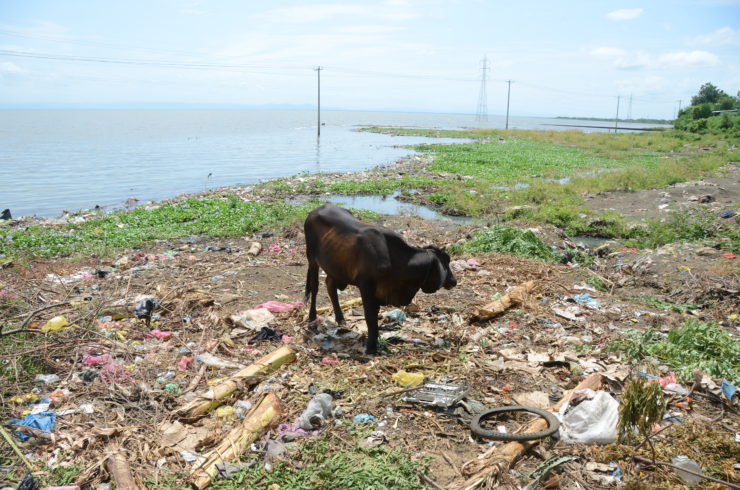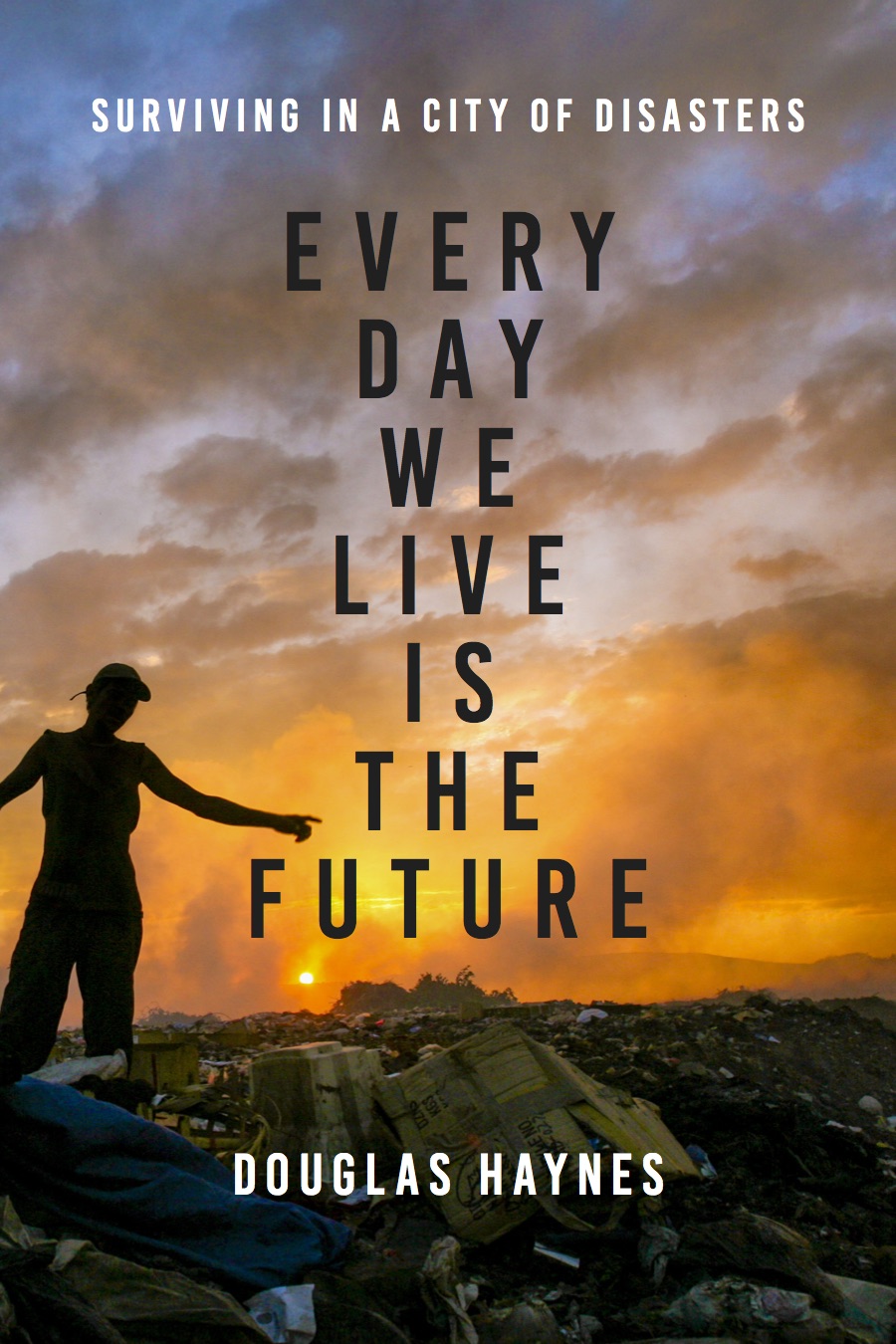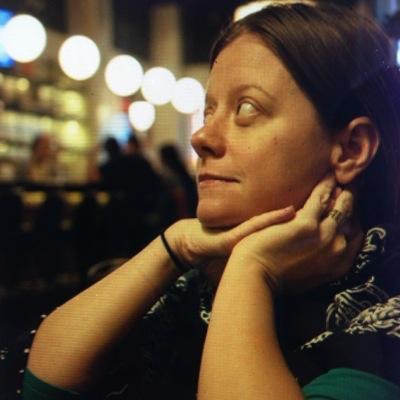
An animal stands among garbage.
Douglas Haynes spent nearly 10 years working on his book “Every Day We Live is the Future: Surviving in a City of Disasters.” So when it was finally published late last year, he was understandably gratified that his decade-long project following the lives of two Nicaraguan women and their families had finally come to fruition.
“I hope they’ll think about the impacts as not just dramatic events we see in headlines, but as the sum of small disasters – that small disasters can be just as harmful as big ones.”
But it was only when he returned to Nicaragua last month and placed the book in the protagonists’ hands that he began to realize the full significance of his efforts – and theirs. “Yadira and Dayani were flabbergasted that anyone would care about their lives,” he said to me in a phone conversation. “When they got the book, it made it real for them.”
“Every Day We Live is the Future” is a dispatch from the frontiers of climate change, told through the lens of the long-term relationships that Haynes developed with two women, Dayani Baldelomar and Yadira Castellón. Both women live in Managaua, Nicaragua’s capital, though they were born in rural areas of the country, and both are engaged in a hard, long-term effort to lift their families out of poverty. They do so in the face of a rapidly changing climate that subjects them to recurrent climate violence.
“In richer Global North cities,” Haynes writes in the book, “climate risks are mostly masked and mitigated by infrastructure, technology, bureaucracy, and insurance.” But in the Global South, the confluence of the impacts of colonialism, rural-to-urban flight, class divides, and dramatic weather events mean that the urban poor are constantly rebuilding their lives with ever-diminishing resources and support.
I spoke by phone with the nonfiction writer and poet, who is also an associate professor of English at the University of Wisconsin-Oshkosh, about his book and the challenges, opportunities and ethics of climate change journalism.

The cover of Haynes' book.
I’m curious to know a bit about the ethics of the book and your approach to telling the stories of Dayani and Yadira. While the whole book was fascinating, the epilogue was particularly compelling. I appreciated how transparent you were about your process. Could you talk about the ethical decisions you made about telling the story of people whose lives you became so personally involved in?
It’s fair to describe them as ethical challenges and quandaries – there are things I lost sleep over and still think about; I’m still entwined in their lives. I’m constantly wrestling with my obligations as an author, as a human being, and as a friend…. It’s a rich, complicated topic. One of the questions I’m often asked is to reflect on my own positionality with relation to people in the book and I do that in the author’s note. There was no way for me to pretend that I wasn’t covering vast distances economically, culturally, linguistically, gender-wise… but their stories were so compelling that I just kept coming back to: “If I don’t do it, who will? Is it better not to tell these stories because I am privileged and I will have to try to cross a lot of bridges here, or is it better to make the effort and be as conscious as I can about those differences? For me, it always came back to the [belief that] the stories were more important and those people’s voices are more important. The bottom line is: It’s better to go than to stay at home. I’d rather be involved in trying to create bridges between these worlds than to pretend like they don’t exist. The basic idea was to bear witness, to do what I could, and the whole rich tradition of narrative journalism informed that. Being transparent was one of the first things I could do, not only with my audience, but also with the people I was writing about – to try to be very clear about what they could expect from being involved in this project.
The lives that Dayani and Yadira and their families are living are so intense, so marginal — with something as urgent as climate change, which is really, at its heart, what this book as is about, is it possible to be objective?
I think what we’re so often missing in the story of climate change and what I tried to draw out in this book is, first, the ordinary details of people’s lives, the lives of people who are most impacted, and how climate change is not just a story about the massive storm that grabs headlines, but it’s a slowly unfolding, cumulative disaster, and that in order to cover that, we have to take time, long periods of time, following the same people in the same place, particularly in marginalized places, and then we have to put that in a historical, cultural and geographic context. The climate violence people experience is going to be different depending upon the location, and in the context of Nicaragua, the rapid urbanization is a force that converges with other forces. That’s part of why it’s so violent: It’s not that these one-off extreme weather events, but that these events further exacerbate inequality and converge with rapid urbanization to make people’s ability to get out of poverty or lead any kind of stable life even harder, which will have short-term and long-term effects at the individual and community level. I try to tell that bigger story through this smaller story. I’m so committed to the idea that ordinary people’s lives are where we’re really going to see the impacts and be able to connect to them most vividly and viscerally.
What do you hope readers will do with the book? You give a lot of space to Women in Action, which helped the people in your book. What are concrete actions you hope readers might take after reading Dayani’s and Yadira’s stories?
I did want to give readers a very tangible point of connection, not only with something that they can do, but with the place. For me, that’s been something transformative in my own life, these long-term connections with people and places in Central America. If the book encourages people to get out and go there or connect through an organization to learn people’s stories first-hand, I think that can be transformative.
But I also hope that people will read climate change news a little bit differently as the result of reading this book. I hope they’ll think about the impacts as not just dramatic events we see in headlines, but as the sum of small disasters – that small disasters can be just as harmful as big ones. I hope that they think about the issue of inequality between north and south, and not just feel guilty, but to go beyond and ask what ways the political life of the Global North can change to engage differently with the Global South, particularly around climate change. This is a conversation that I hope people will think about differently after they read the book. I hope that they understand that the people who are suffering the most are those who have done the least to cause climate change. Central America is one of the most climate vulnerable places in the world. It’s just relentless climate instability and it’s not on the map in the United States at all. It’s so close and our histories are so intertwined.
“Climate change is not just a story about the massive storm that grabs headlines, but it’s a slowly unfolding, cumulative disaster, and that in order to cover that, we have to take time, long periods of time, following the same people in the same place, particularly in marginalized places.”
Can you talk about the reactions of Dayani and Yadira and their families to receiving the book? What have they come to expect from your relationship with them?
Dayani was quite moved, and she had always been a bit more interested in the process of the book and the idea of publication. For Yadira, she wanted me to listen to her. For Dayani, seeing the book and holding it in her hands brought all sorts of emotions flooding back for her, mostly about her sons. There was gratitude for the time we’ve spent together, which was really an exchange, something we both learned tremendous amounts from; we reflect on that often together.
Yadira and Dayani were flabbergasted that anyone would care about their lives. When they got the book it made it real for them. I don’t know that they have a lot of expectations about the book. What Yadira has frequently told me over the years is that the process of doing the book allowed her to connect with a lot of family members that she’d previously lost touch with. So when I went with her to her birthplace on the border of Honduras, there were all these people that she hadn’t seen in years. I think she hadn’t expected that and it was one of the most important aspects of the book for her.
Financial help is an ethical issue I’ve had to negotiate. I’ve been very clear that it wasn’t my role [to provide financial support]. Since the book was published, I’ve thought about it differently. I still see my role as not giving money directly because I don’t think that’s going to change their lives, but I’ve helped raise money for Ana Teresa [one of Yadira’s daughters] to be able to continue school. She’s finishing up pharmacy school at a private university that charges a lot of fees. They came to me in the past year to ask for money, and it was something I had to negotiate.
How are Dayani and Yadira and their families now? What has happened since the narrative of the book ended?
Dayani is better than I’ve ever seen her in terms of her personal stability and her mental health. She works for a priest as a domestic in Costa Rica and she has a new partner and her life is very stable; he’s very stable. They live in a quiet, touristy area of northwest Costa Rica. What is continually challenging for her is negotiating her relationships to her sons and trying to figure out how to best help them. They don’t seem to want to be helped and her emotional relationship with them is very complicated.
Yadira and [her husband] Henry are economically doing okay. They’re eating well. Their youngest son, Byron, has a job working for the city that keeps them stable. Henry has a couple moto taxis and he’s bringing in money that way. Wendy [one of their daughters] went to Costa Rica and Ana Teresa is finishing school and Yadira is at home with Jason [their son, who has a disability]. They kind of missed the window to help him get treatment, but their care for Jason is one of the things that remains most impactful for me — the way he’s never been viewed as a burden. They see him as a gift and the whole family is constantly involved in his care.
Whether they can become much more financially secure really depends upon what happens with Ana Teresa and whether she can find a job with her pharmacy degree. One of the big challenges in the Global South is not the lack of education, but the lack of job opportunities.
Can we close by talking a little bit more about the process of researching and writing the book?
What’s really important to me was trying to tell a story over a long span of time. If I couldn’t be there all the time, what I could do was present a story that wasn’t just a one-off immersion but really showed gradual small changes over a five-year period when I was intensively involved, as well as a bigger story of three generations and rural to urban migration. There was a challenge of reconstructing the past, of recreating things I didn’t witness. This involved a lot of site visits and travels with Dayani and Yadira and layers and layers of interviews.
The book is a story about Nicaragua and Central America, but this is a place that prefigures the future for us. For me, Managua is the quintessential city of the future, not in a technological way that we often talk about cities of the future, but in terms of that convergence of rapid urbanization, the spread of informal squatter communities and the climate violence that is going to be affecting them most significantly. That phenomenon that happened in Latin America of rapid urbanization in the past 50-60 years is now taking place in Africa and Asia. I wanted to point toward this idea that what we see in these stories is going to be replicated elsewhere. By 2050, it’s projected that half the urban population on the planet will be living in informal settlements like The Widows [where Dayani and Yadira lived in most of the book] and these people may not be representative but the issues they face are – they’re the issues we’ll be facing around the world more and more.


